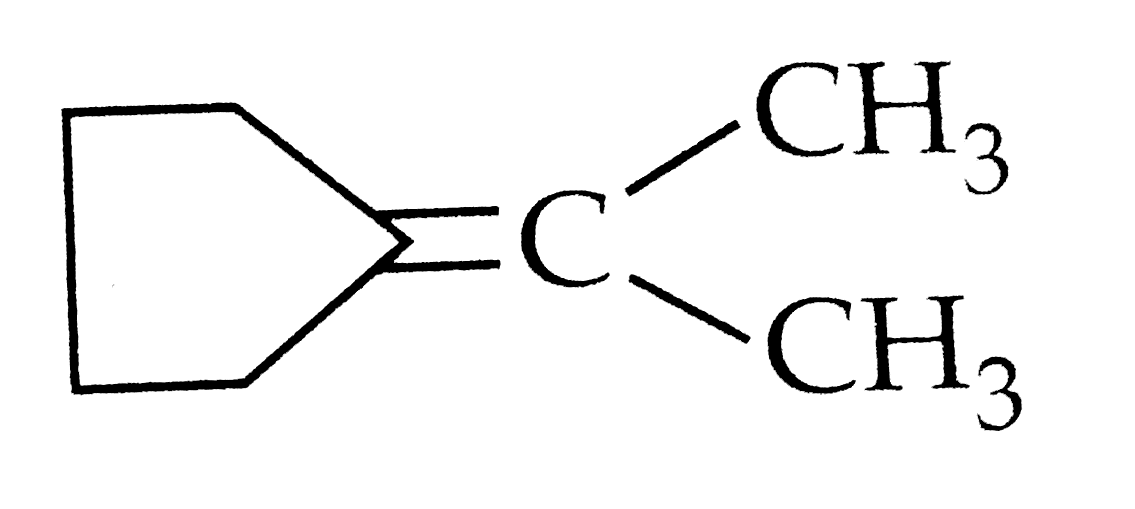One mole of alkene an ozonolysis gives two moles of butanone. The alkene is :
2, 4-dimethylhex-2-ene
2, 3-dimethylhex-3-ene
3, 4-dimethylhex-3-ene
2, 4-dimethylhex-2-ene
The correct Answer is:C
To solve the problem of identifying the alkene that, upon ozonolysis, yields two moles of butanone, we can follow these steps:
Step 1: Understand Ozonolysis
Ozonolysis is a reaction where alkenes react with ozone (O₃) to form carbonyl compounds (aldehydes or ketones). The double bond in the alkene is cleaved, resulting in the formation of carbonyl groups.
Hint: Recall that ozonolysis typically breaks the double bond of alkenes and forms carbonyl compounds.
Step 2: Analyze the Product
The problem states that one mole of alkene produces two moles of butanone. Butanone (C₄H₈O) has the structure CH₃COCH₂CH₃. Therefore, the ozonolysis of the alkene must yield two molecules of butanone.
Hint: Identify the structure of butanone and consider how it can be formed from an alkene.
Step 3: Determine the Structure of the Alkene
To produce two moles of butanone, we can deduce that the alkene must have a double bond that, when cleaved, results in two identical carbonyl fragments that correspond to butanone. The simplest way to achieve this is to consider an alkene that has a symmetrical structure.
The alkene that fits this description is 3,4-dimethyl-3-hexene. When ozonolysis occurs on this alkene, it breaks down to yield two molecules of butanone.
Hint: Consider symmetrical alkenes that can produce identical carbonyl products upon ozonolysis.
Step 4: Write the Reaction
The ozonolysis of 3,4-dimethyl-3-hexene can be represented as follows:
1. Starting Alkene: 3,4-dimethyl-3-hexene
2. Ozonolysis Reaction:
- O₃ + Alkene → Ozonide
- Ozonide + H₂O (hydrolysis) → 2 Butanone
Hint: Write out the ozonolysis reaction to visualize how the alkene transforms into the carbonyl products.
Conclusion
Thus, the alkene that gives two moles of butanone upon ozonolysis is 3,4-dimethyl-3-hexene.
Final Answer: The alkene is 3,4-dimethyl-3-hexene.
Ozonolysis is a reaction where alkenes react with ozone (O₃) to form carbonyl compounds (aldehydes or ketones). The double bond in the alkene is cleaved, resulting in the formation of carbonyl groups.
The problem states that one mole of alkene produces two moles of butanone. Butanone (C₄H₈O) has the structure CH₃COCH₂CH₃. Therefore, the ozonolysis of the alkene must yield two molecules of butanone.
To produce two moles of butanone, we can deduce that the alkene must have a double bond that, when cleaved, results in two identical carbonyl fragments that correspond to butanone. The simplest way to achieve this is to consider an alkene that has a symmetrical structure.
The ozonolysis of 3,4-dimethyl-3-hexene can be represented as follows:
2. Ozonolysis Reaction:
- O₃ + Alkene → Ozonide
- Ozonide + H₂O (hydrolysis) → 2 Butanone
Thus, the alkene that gives two moles of butanone upon ozonolysis is 3,4-dimethyl-3-hexene.
Similar Questions
Knowledge Check
An alekene X is obtained by dehydration of ann alcohol Y. X on ozonolysis gives two molecules of ethanal for every molecule of alkene. X and Y are
AX=3-hexene,Y=3-hexanolBX=2-butene, Y=2-butanolCX=1-butene, Y=1-butanolDX=1-hexane, Y=1-hexanolWhich of the following alkenes on ozonolysis gives a mixture of ketones only?
ACH3−CH=CH−CH3BCH3−C∣CH3−CH=CH2C DH2C=CH2
DH2C=CH2An alekene X is obtained by dehydration of ann alcohol Y. X on ozonolysis gives two molecules of ethanal for every molecule of alkene. X and Y are
ACH3CH2CH2OHBCH3CH2OHCCH3CH=CHCH2OHDCH3CH2C∣OHHCH3
Linear polyenes on ozonolysis gives two moles of acetaldehyde and one mole of propanedinal. Linear polyene will be
View SolutionAn alkene on reductive ozonolysis gives two molecules of CH2(CHO)2. The alkene is:
View SolutionAn alkene ‘A’ contains three C – C, eight C – H (σ) bonds and one C – C (π) bond. ‘A’ on ozonolysis gives two moles of an aldehyde of molar mass 44 u. Write IUPAC name of ‘A’.
View SolutionAn alkene on ozonolysis yields only ethanal. There is an isomer of the alkene which on ozonolysis yields:
View SolutionOne mole of a hydrocarbon on ozonolysis yirlds one mole of glyoxal and two moles of formaldehyde. The hydrocarbon is :
View Solution
